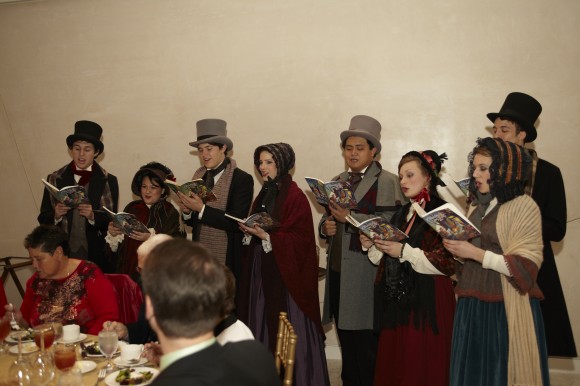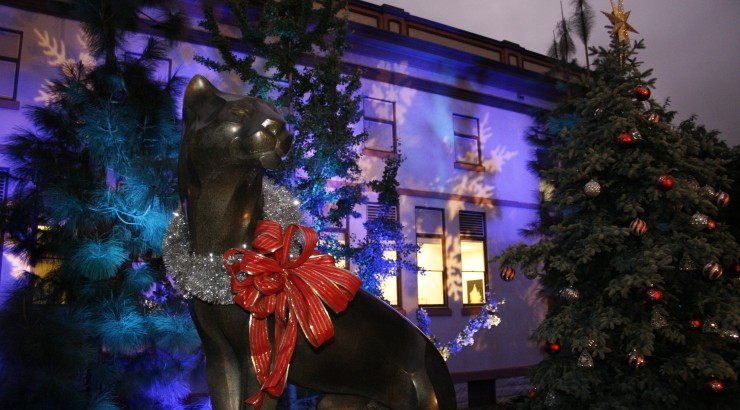Christmastide
November 25, 2014
In this guest blog, Mary Ellen Barnes ’50 offers insight into the history of the Christmas season around the world and sheds light on the origins of many common symbols of the season including Christmas trees and Yule logs. If you’d like to celebrate the season with Chapman University, join us for the 3rd annual Winterfest on Thursday, December 4 at 5 p.m. when the beautiful Attallah Piazza will come alive with lights, music and festivity.
In ancient times the winter solstice prompted much ado about the sun. In the festival of Saturnalia, a celebration of the returning sun, December 17 to 24, Romans partook in feasting, drinking, gaming, processions, and gift exchange. Astutely, the early Christian church fathers arbitrarily set the date of Christ’s birth near this holiday in an effort to replace it. After the acceptance of Christianity by the emperor Constantine in the early fourth century, this pagan observance rapidly declined.
For centuries Christians continued to be concerned about the sun. Generations of English farmers observed age-old customs to ensure good crops for the next year. On Christmas Eve a farmer might attach a plum cake to a cow’s horn and throw cider in her face. The way the cake fell when she tossed it to the ground indicated the outcome of their crops.

Strolling minstrels entertain guests at Chapman’s annual Wassail banquet and concert, now in its 51st year.
Farmers toasted or “wassailed” fruit trees with ale and cider. “Wassaile the Trees that they may beare you many a Plum and many a Peare. . .” Cakes were stuck on the trees and cider sprinkled on them. The celebrants made certain they had plenty more for them to eat and drink.
Yule is a Scandinavian celebration. Weather-bound Vikings would stay in their great hall warmed by drink and Yule logs. Bringing in the Yule log was an important part of European midwinter celebration. Adding remnants of the former year’s log to the new fire ensured good luck for the coming year. This rite also signified the rekindling of the sacred hearth, the center of family life.
The origin of the Christmas tree is obscure but may stem from the ancient worship of the spirit of growth when homes were decorated with lights and greenery. In old England people brought in holly, ivy, and mistletoe to adorn their homes. But in early Christian times mistletoe was not used because the old custom of kissing smacked of pagan fertility rites in Druid worship. The Welsh called an oak tree with mistletoe “a tree of gold,” source of the sun’s golden fire.
Fire, light, and sun all figure in accounts of the midwinter season, whether pagan or religious. Still dependent on the sun for heat and food production, today we have the same fears about the sun that our ancestors did—and with better reason. We are blotting out the sun with our pollution. Increasing weather variability with droughts and flooding play havoc with food production and lives of people all over the world. As we celebrate Christ’s Mass, let us keep an eye on the sun and treat our planet Earth with more respect.
The Christmas holiday ends for some when pine needles crunch under foot and gifts have been stowed or returned to stores. However, the Christian Church observes Christ’s birth right up to January 6—Epiphany or Twelfth Day—the day commemorating the appearance of the Magi.
The Magi, an ancient Persian sect, were astrologers, priests, and sometimes magicians. (From
Magi
we get the word,
magic
.) Early accounts mention twelve travelers who followed that bright star, but by the sixth century the number was pared down to three: Gaspar, Melchior, and Balthasar; their gifts of gold, frankincense, and myrrh symbolized kingship, priesthood, and death. As astrologers they would have been aware of anything unusual in the vast desert sky—a comet, a new star, or the conjunction of planets—celestial phenomena recorded throughout the ages and thought to hail the birth or death of royalty. Acquainted with the Jewish prophecy foretelling the coming of a Savior, these men followed the brilliant star in the East to Bethlehem. However, Biblical scholars have little consensus about the date when they appeared to honor the Holy Child.

Attallah Piazza is transformed into a winter wonderland for Winterfest, a celebration of the holiday season.
The visit of the Magi caught the imagination of early Christians. In Spanish lore the three wise men brought gifts to good children who left straw-filled shoes on window ledges or balconies for the camels. Boys in Madrid, equipped with torches, bells, and tin cans, went forth to meet the procession of the Magi and to make a little noise, as boys delight in doing.
In Italy “Epiphany” has been corrupted into “Befana.” She is an old witch who swoops through the air on a broomstick and pops down chimneys with gifts and candy for good children on Epiphany Eve. For those who have misbehaved she leaves only a lump of coal.
Frivolity ruled in England on the Eve of January 6. By the reign of Charles I, extravagant masques for Twelfth Night included castles of cake that exploded and claret that flowed from stags made of paste. Nobles pelted each other with eggs filled with rose water, and ladies shrieked as live frogs jumped out of huge pies. English kings observed Twelfth Day in processions to the royal chapel, appropriately carrying an offering of gold, frankincense, and myrrh.
On Twelfth Night in rural England in early times, fires blazed on hilltops, symbolizing Christ and His twelve apostles. While men drank apple cider around the fires, at home their wives prepared a festive meal but locked out the men until they sang for their supper. For dessert they relished a slice of Twelfth Cake, a rich spice cake lavishly decorated with sugar crowns and accompanied by plenty of wassail. Whoever bit down on a bean or a pea baked inside the cake became King or Queen of the evening. After the Twelfth Night festivities, partyers raised their glasses with a toast:
“May the great time in you still greater be,
While all the year is your Epiphany.”
Wherever we dwell, let us pray for a verdant Earth and the preservation of all God’s creatures upon it. Let us discover and celebrate our own Epiphanies in this coming year.
About the Author
A native of Tucson, Ariz., Mary Ellen (Zimmerman) Barnes graduated from Chapman College in 1950 with a bachelor of arts in English. Copies of four of her books are in Chapman University’s Leatherby Libraries:
Forged by Fire: The Devastation and Renewal of a Mountain Community
;
The Road to Mount Lemmon: A Father, A Family, and the Making of Summerhaven
;
Teresa and the Cowboy: Un Cuento de Amor Tucsonense
; and
Peregrine
.

